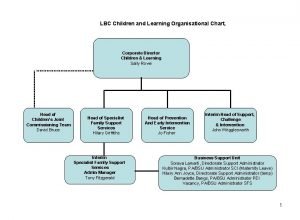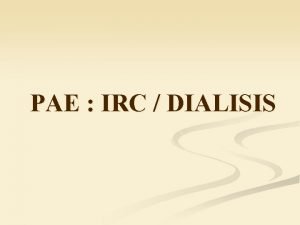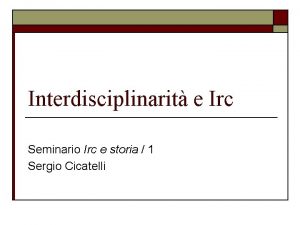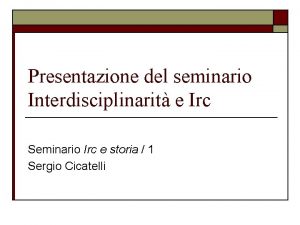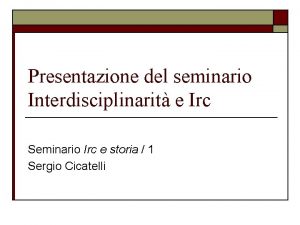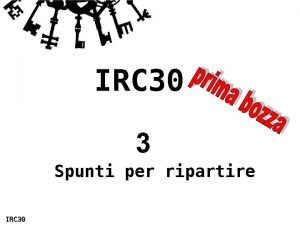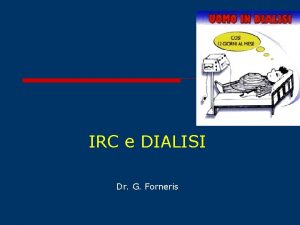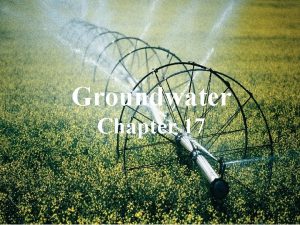Introduction to Groundwater Photo Joanne OfferThe IRC Groundwater











- Slides: 11

Introduction to Groundwater Photo: Joanne Offer/The IRC

Groundwater is water that has permeated or percolated into the ground. It is an important part of the water cycle. Groundwater is an important source of water in the U. S. There are 3 factors that determine whether a source of groundwater will be a viable resource: 1. quantity 2. ease of withdrawal 3. water quality NASA USGS There is more water underground than in all the lakes and streams on the Earth’s surface.

Wikipedia Porosity v. Permeability Most groundwater is in billions of tiny spaces (pores) between mineral grains or in fractures - dependent on the porosity and permeability. Porosity is the proportion of a material that is made up of spaces (e. g. if ½ the total volume of a rock is pore space, the porosity is 50%) Porosity varies with the packing arrangement and sorting of grains

Permeability is the capacity of water to flow through earth materials. Water can flow readily through materials with well connected pore space or many fractures. Connections between pore spaces are wider in coarsegrained material (gravels) than fine-grained material (sand). High permeability does not always go hand in hand with high porosity.

Wikimedia: Hans Hillewaert Groundwater is stored in bodies of rock and/or sediment called aquifers, which are composed of sufficient saturated permeable material to yield significant quantities of water. Good aquifers have high porosity and high permeability (high hydraulic conductivity). Most productive aquifers are found in unconsolidated earth materials (80% of all groundwater withdrawn in U. S. comes from sand gravel aquifers).

Wikimedia: Hans Hillewaert Aquitards are low-permeability materials such as clay, shale, or unfractured igneous or metamorphic rock, that act as a barrier to water flow. An unconfined aquifer is an aquifer covered by soil (“open” to above). A confined aquifer is an aquifer covered by an impermeable layer of rock or clay.

The saturated zone is where the pore spaces are filled with water. The unsaturated zone (aka. zone of aeration) is located above the saturated zone and the pore spaces are generally partly filled with water. The water table is the upper surface of the saturated zone. regentsearth. com

Stephen A. Nelson, Tulane University Groundwater flows due to differences in elevation and water pressure. Hydraulic head may be thought of as the height of the water table. Hydraulic gradient is the slope or steepness of the water table (unitless number). hydraulic gradient = ∆h/distance Groundwater always flows from a region of higher hydraulic head to lower. Groundwater velocity increases as the gradient increases (steepens). 8

Goundwater overdraft is where the supply cannot replenish as fast as we extract it for human use and results in a decline in water table. The water table surrounding a well can decline if water is pumped out too fast. The surface of the depleted water table forms a cone of depression around the well. Cornell Cooperative Extension, Cornell University Rapid population growth in an area usually results in a greater reliance on groundwater as a water source.

Nature can cause contamination of groundwater, but it is commonly due to human activities. Sources of human and natural contamination can be from point sources and nonpoint sources. A point source contamination can be specifically identified and located at a specific location such as a leaking gas storage tank or an accident involving chemical tanker trucks and trains. WBMA/abc 3340. com /REUTERS Nonpoint sources occur over a wide area such as runoff from urban streets and agricultural chemicals (fertilizers and pesticides). corncrops. com Contaminants can include dissolved metals, organic and inorganic chemical and microbes.

When a contaminant enters an aquifer, it can spread as a plume as groundwater flows (due to hydraulic gradient or pumping). Solinst Groundwater contamination is very difficult to clean up. Methods include • bioremediation – microbes degrade the contaminant • groundwater pumping and treatment








